Tough times never last, but tough people do.
– Dr. Robert H. Schuller

Some states are easier than others.
For the runner whose goal is to run a marathon or half marathon in all 50 states, one of the toughest tasks can be deciding which race to run in a particular state. Most states offer several appealing options — California, for instance, features at least a dozen highly rated marathons, not to mention all its excellent half marathons and ultras. Conversely, very few states boast one “must run” event that dwarfs the competition; as the oldest and most prestigious marathon in the country, the Boston Marathon in Massachusetts is certainly one of these.
You may be surprised, then, to hear that New Mexico is among the latter — because a short drive from the Texas/Mexico border, on the high desert plains of the White Sands Missile Range, awaits one of the most unique race weekends you’ll ever experience.
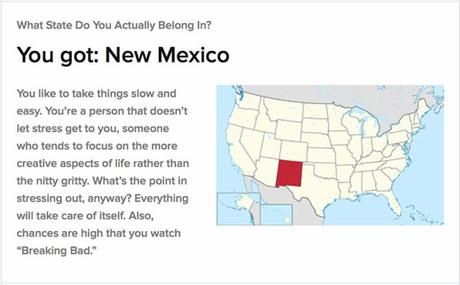
If you can’t trust online quizzes to set you straight, who CAN you trust?
The Bataan Death March (April, 1942)
On April 9, 1942, following the three-month Battle of Bataan and surrender of the Bataan Peninsula, 66,000 Filipino and 10,000 American soldiers were forced by their Japanese captors to march 69 grueling miles from Bataan to San Fernando in temperatures as high as 110°F. Starvation, disease, physical brutality and wanton killings characterized the five-day march, with many soldiers being bayoneted for being too weak to walk.
Though estimates of the death toll range widely, thousands of POWs died along the route from Bataan to San Fernando, with only 54,000 reaching the prison camps at Camp O’Donnell. There thousands more perished from starvation and disease and were buried in mass graves. After the war, an American military tribunal judged the march to be a Japanese war crime and executed the commander of the Japanese invasion forces in the Philippines.
Forty-eight years later, in the high desert of Southern New Mexico on the grounds of the White Sands Missile Range, a living patriotic tribute was created to honor the soldiers who were forced to endure — and who in many cases succumbed to — the atrocities of that march. In so doing, one of the nation’s most inspiring and memorable marathon experiences was born. Established in 1990, this year would mark the 29th annual Bataan Memorial Death March.
I didn’t want to wait for the 30th, and risk missing my opportunity to honor the heroes of Bataan before the sands of time run out on its few remaining survivors.
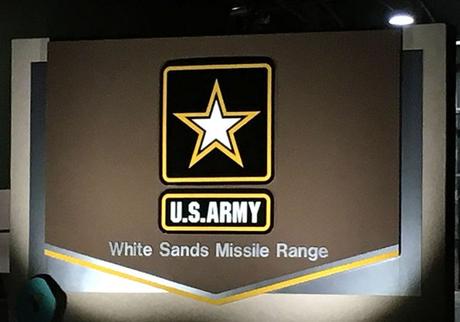
¡Hola, El Paso!
But first, our trip to the Land of Enchantment would start with a detour through my childhood.
In 1972 Frank Sohaskey, recently retired from the United States Air Force after 20 years, packed up the family (including his fleshy pink infant son) and moved from Michigan back to El Paso, TX. I say “back” because as an officer, Dad had been stationed there years earlier, during which time both my sister Sandy and brother Chuck had been born at ironically named Fort Bliss. El Paso offered a familiar and practical setting for the next three years, while our newly civilian father worked to complete his accounting degree at the University of Texas at El Paso (UTEP). From there, his first job offer led us across the state to Dallas. That was late 1975, and the rest as they say…
So West Texas had been home not only to our family for those three years, but to my earliest life memories, most of which involved being chased by man-eating tumbleweeds (underestimate them at your own risk!). I hadn’t been back since our move to Dallas over 42 years earlier; Chuck had returned once and then only briefly. With El Paso being the closest airport to Southern New Mexico and the White Sands Missile Range, we jumped on the chance to visit before making the 40-mile drive to Las Cruces.
And visit we did — our old duplex with its tiny current occupants playing in the driveway and its rock landscaping, a concession to the arid climate; the desert ravine at the end of our street where as a clueless toddler I’d followed my older siblings like the hero-worshiping little brother I was; the middle school they’d both attended; and the indoor mall at Bassett Place which Chuck told us used to be open-air, but which now seemed like so many suburban American malls clinging to the last vestiges of its brick-and-mortar glory.

Behold! My El Paso playground as a 4-year-old… what could go wrong?
El Paso (population ~683,080 in 2016) shares much of its western border with Ciudad Juárez in Mexico, the Rio Grande forming a natural border between the two nations. It’s the second busiest international crossing point in the U.S. behind San Diego. But unlike San Diego with its high-priced beach communities, pro sports teams and year-round sunshine, El Paso feels distinctly laid-back and low-key, like a place that time — if not forgot, then at least deprioritized. Our brief visit brought to mind a true border town in the Old West, Cormac McCarthy sense of the word. And it reminded me why the Southwestern U.S. is one of my favorite regions of the country.
The city owes its demographics in large part to immigration, with Hispanics and Latinos accounting for over 80% of its population. At the same time, it’s consistently among the safest metro cities in the country, despite its high poverty and low median income — a fact that flies in the face of conventional wisdom on the role of socioeconomic status in crime.
As we drove north on I-10 toward New Mexico, I gazed across the border and shook my head at the thought of a physical wall separating our two nations — a multibillion-dollar testament to the racism, xenophobia and callous ignorance that, for now at least, wield an empowered megaphone in the one nation on earth that should be able to rise above its own inner demons.
“The drugs are pouring in at levels like nobody has ever seen,” claims our misinformed Commander-in-Chief. “We’ll be able to stop them once the wall is up.” Never mind that in 2015, 95% of drugs coming into the US entered via container ships and other vessels — and good luck stopping that access with a border wall. [Cue 45 tossing his page of prepared notes over his shoulder.]
As much as our leadership in 2018 may treat the truth like a soiled diaper, them’s the facts. And the only thing a wall would do is keep all Americans on the wrong side of history.

Our first view of White Sands Missile Range and the San Andres Mountains
White Sands and a living history lesson
Chuck, Laura, Katie and I rolled into Las Cruces, NM on Friday evening, then drove 30 miles east to White Sands on Saturday for “In-Processing” and packet pickup. We’d been told to bring valid ID plus current registration and proof of insurance for our car, and to expect delays at In-Processing. Luckily our official Vehicle Pass (emailed by the organizers before the race) enabled us to enter the complex with minimal fanfare.
White Sands Missile Range (WSMR), which its logo calls “the birthplace of America’s missile and space activity,” is the largest military installation in the country. Established in 1945 as the White Sands Proving Ground, the first atomic bomb test — code named Trinity — was conducted near the range’s northern border, three weeks before the US detonated the first atomic bomb over Hiroshima, Japan. (Side note: the Trinity Site is open to visitors but only two days per year, one in April and the other in October. So plan accordingly and expect crowds.)
For the Memorial Death March, all race activities take place on the southern end of the range, closer to Las Cruces and some 100 miles from the Trinity Site. In-Processing happened at the MST Building adjacent to the Bataan Ceremony Field, where the race would begin the following day.
In-Processing was quick and easy, followed by a brief walk-through of the exhibitor booths, some of which were selling Bataan memorabilia while others (understandably) were targeted more toward military personnel and their families. On display along one wall were US and world maps that looked like paper pin cushions, their colored pins indicating each marcher’s self-reported country of origin. I didn’t take a magnifying glass to Delaware or Rhode Island, but every US state looked to be represented along with over two dozen other countries. Not surprisingly, the density of pins was particularly high in the Philippines.
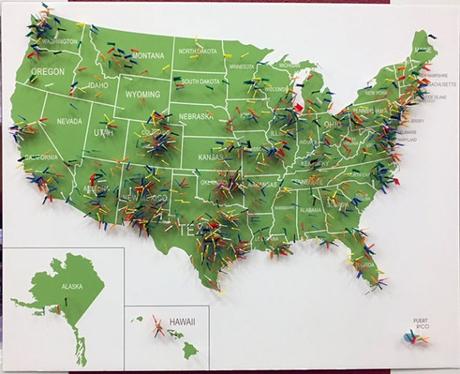
Bataan marchers hailed from all 50 states (and several countries)
Playing on a loop in the center of the room was a 6½-minute course video. And though its speed (26.2 miles/390 seconds = 1 mile/15 sec = 240 miles/hr) coupled with the lack of camera stabilization made me wish I’d taken Dramamine, the footage gave us a good sense of what lay ahead. So I’ve added the YouTube video to the RaceRaves Bataan race page.
From In-Processing we made the short drive to the White Sands Museum & (outdoor) Missile Park. There an assortment of missiles and rockets tested at White Sands stood proudly on display, an impressive testament to America’s mililtary might through the years. Walking among the weaponry pointed in different directions as if ready to dispense death and destruction at a moment’s notice, I felt like Ant-Man shrunk down to insect size and surrounded by the model rockets of my childhood (though admittedly mine had better paint jobs). Patriot, Pershing, Nike, they were all there — even a replica of Fat Man, the second nuclear weapon dropped on Japan and the last to be used in warfare.
Watching a frazzled mom try to regain control of her offspring, it hit me — there’s nothing more surreal than the giggles of two small children chasing each other around an atomic bomb that once killed 75,000 people.
Equal parts awe-inspiring, thought-provoking and unnerving, a visit to White Sands without touring the Missile Park would be like a trip to Yellowstone without seeing Old Faithful.
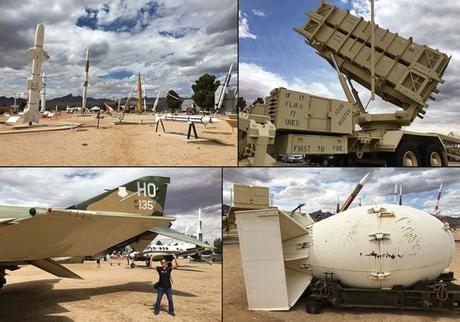
Scenes from the White Sands Missile Park (clockwise, from upper left): American firepower on display; Patriot Missile launcher; bomb casing for Fat Man, the atomic weapon dropped on Nagasaki; Katie finds the family jet?
Our final stop of the day at WSMR would be the highlight of the weekend, as we attended a “Meet the Bataan POWs” session where we listened to retired US Army Colonel, Professor Emeritus of English at Clemson University and Bataan survivor Ben Skardon. Remarkably, at 100 years of age Colonel Skardon is not only very much alive, but he still marches the first 8½ miles of the marathon course each year. (Go ahead and read that again, I’ll wait.)
Colonel Skardon injected some levity early when the wail of an ambulance siren outside interrupted his opening remarks — “I hope that’s not for me,” he quipped. He then recounted from prepared notes, with a clear voice and keen ear for detail, his recollections of the brutal march in which disease and hunger were his constant companions. With no hint of animosity toward his Japanese captors he emphasized survival, loyalty, faith and the importance of never giving up hope. His words and the humility with which he delivered them earned him a well-deserved standing ovation from the enthralled audience.
We decided against that evening’s pasta buffet, opting instead to eat closer to our hotel in Las Cruces. We certainly didn’t leave hungry, though, as the day had given us plenty of food for thought. Now we just needed plenty of carbohydrates to get us through the next morning.
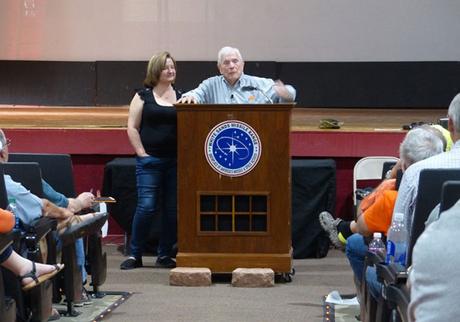
Colonel Ben Skardon, USA, Ret. details his experience on the original Bataan Death March
The 29th Bataan Memorial Death March: Opening Ceremony
Sunday, 6:15am. Harsh electric lighting exploded the pre-dawn darkness as we pulled into the grass parking lot adjacent to the Bataan Ceremony Field. The looming silhouette of the San Andres Mountains provided a majestic backdrop for the day’s mission. Our 30-minute drive had been extended to over an hour by the slow yet steady crawl of traffic into the installation, our last four miles taking longer to cover than the first 28.
Despite my pullover, I shivered in the desert chill as we made our way toward the field for the opening ceremony. The morning’s schedule called for all marchers to report to their designated start corral on the field no later than 6:00am — wishful thinking given the traffic and the fact that this year’s 8,460 marchers would be the largest in the event’s 29-year history. As the opening ceremony got underway at 6:35am, we joined many of our fellow marchers — both civilian and military — in the time-honored marathon tradition of waiting in line for the porta-potties.
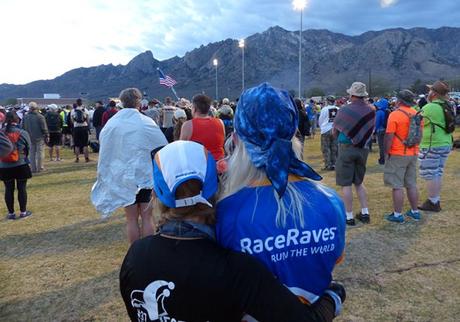
Laura and Chuck soak in the Opening Ceremony
And that would be our vantage point for most of the ceremony. As the first tinge of daybreak painted the edges of the sky, the Garrison Commander welcomed the crowd and reiterated our common goal: “to honor the heroes of Bataan in a living history lesson.”
The presentation of the Color Guard was followed by the singing of the Filipino and American national anthems. And that was when the goosebumps cascaded like dominos down my neck and arms, because this was the most powerful live performance of the national anthem I’d ever heard. In that moment, as the impassioned vocals seemed to usher in the sunrise and lift the remaining darkness, it was clear to me how patriotism can serve as a double-edged sword for both pride and prejudice.
Seven Bataan survivors (including Colonal Skardon) were in attendance to answer the Symbolic Roll Call. And for anyone reading this who’s interested in running or marching, I’d urge you to do so soon while these gentlemen are still alive to share their stories and bring the weekend to life. Though its objective may remain the same, BMDM will be a dramatically different event once they’re gone.
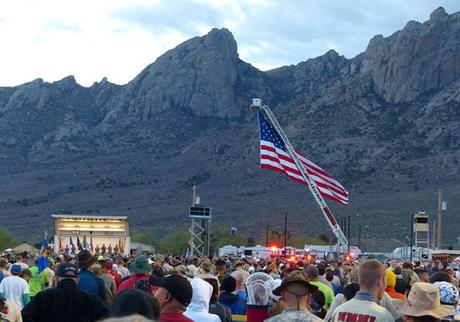
The opening ceremony concluded with a flyover of twin F-16 Fighting Falcon jets as we entered the runners-only corral at the far end of the field, closest to the start line. As runners, we’d have the opportunity to start near the front, ahead of the corrals for the civilian and military marchers in both the “heavy” and “light” divisions.
A significant number of the nearly 8,500 marchers would be military personnel in full uniform. And as if marching in uniform weren’t enough of a challenge, a lot of these officers would be carrying a 35-pound rucksack on their back (its weight validated at In-Processing) to qualify them for the “heavy” division. Like their military counterparts, civilians could choose to march with (heavy) or without (light) a pack, with most of the packs carrying food to be donated at the end of the race.
Months before, when I’d first resolved to run Bataan, I’d briefly contemplated the notion of entering the heavy division and wearing a 35-lb pack, only to come to my senses soon after. No, I realized, I had zero desire to test my mettle with 8+ hours of nonstop core strengthening under the hot desert sun on sandy terrain a mile above sea level — fun as that may sound. And while I’m all in on helping to feed as many underserved people as possible, I’d rather not carry the food on my back during the race.
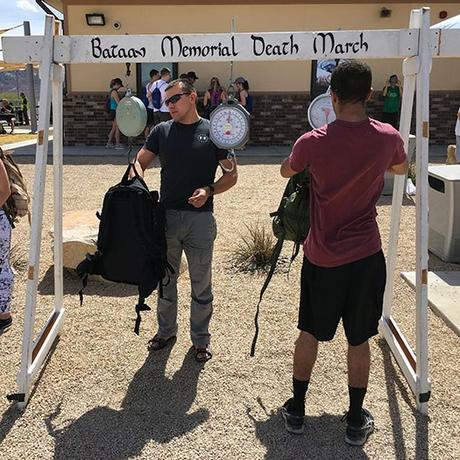
The official weighing of the 35-lb packs for the Heavy Division
Don’t get me wrong, I’m a masochist. But if I wanted to do a Spartan Race, I’d do a Spartan Race — and I’ll never do a Spartan Race. I’m a runner, not a marcher or obstacle course guy. For military personnel at Bataan, I understand and respect the solidarity of marching with a pack. But I don’t feel the need to prove my toughness by carrying extra weight or splashing through mud or crawling under chain-link fences or climbing over walls. Busting my ass to get from start to finish in the shortest time possible is enough for me. The rest is just silly distraction.
Back on the field we waited for several minutes while the seven Bataan survivors followed by the Wounded Warriors exited first to a round of applause. And finally, with the sun now above the horizon and the clock closing in on 7:30am, a cheer erupted as our corral began to move. Chuck, Laura and I said our goodbyes to Katie who would be our support crew for the day, and broke into a jog as we hit the paved surface leading to the main road.
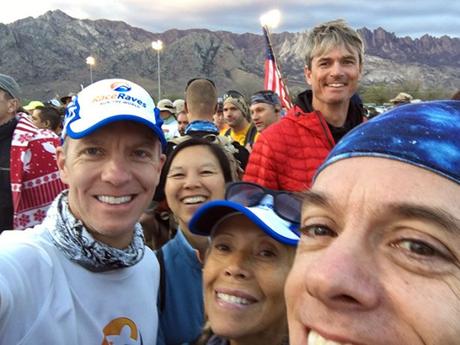
No better way to calm pre-race jitters than a goofy group selfie
My goal would be to maintain a four-hour (9:09/mile) pace for as long as possible — easier said than done after the previous weekend’s Los Angeles Marathon, where I’d pushed just hard enough to punish my quads and improve my corral seeding at June’s Comrades Marathon in South Africa.
We passed under a nondescript white metal structure equipped with a number of rectangular appendages, a framework that looked like something you might expect to see set up in the desert to detect radio waves from space. Was that the start arch? I wondered as we passed beneath it. Chuck seemed confident it was (apparently those “appendages” were timing sensors) and started his Garmin, so I did the same. Then I fell in step behind him as we headed out of the base, following the masses onto the main road and into the rising sun.
Who knew our first right turn would be so wrong…
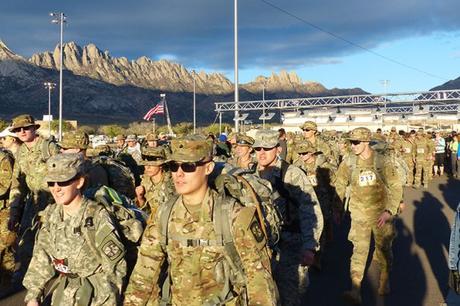
Forward, MARCH! Race start for the Military Heavy Division
When the going gets tough… (miles 1 – 14+)
Other than a brief and seemingly unnecessary stretch of running on the grass, the first three miles were on asphalt. Which would have been fine, if only the first three miles were supposed to be on asphalt. But as Chuck recalled from the course video the day before, we were supposed to transition onto dirt by mile two. Which could only mean one thing…
Continuing east with the sun in our eyes, we looked up in confusion to see the hazy silhouettes of runners ahead of us now approaching in the opposite direction, many of them moving slowly and looking — well, lost. And I knew this wasn’t an out-and-back course.
I would love to have had a bird’s-eye view of the course at that moment, as hundreds of runners made a U-turn en masse and headed back the way we’d come. My unease at realizing we’d come the wrong way was soon replaced by the frustration of not knowing which was the right one. To be sure, I’ve taken wrong turns at races before — but never so early, and never crowdsourced to this extent. How had this happened?
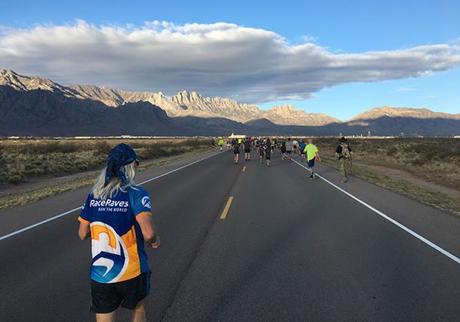
Chuck heads toward the horizon after a brief detour
Turns out I may never know, but the why didn’t matter right now as much as the how — as in, How the hell do we get back on track? This year’s course — at least the start — was new, and clearly the organizers hadn’t worked out all the kinks. But how had there not been clear signage and plenty of orange pylons at that first critical turn?
Moments before I’d remarked on how nice it was, after Houston and Los Angeles where I’d started at or very close to the back of the pack, not to be weaving around other runners. And now here we were, trying to make up for lost time by… weaving around other runners. This was ironic in the most Alanis-like way. And the hordes of marchers streaming onto the main road ahead of us like a human tributary only added to our workload and frustration.
We passed Laura heading back the way we’d come, and I texted Katie to let her know what had happened. Spectators weren’t able to access the course, and I didn’t want her waiting at the finish line anxiously with no sense of timing.
I counted myself among the luckiest wrong-turners since a) I was in good enough shape that the bonus mileage didn’t bother me, and b) I wasn’t wearing a nylon/cotton uniform or carrying a 35-lb rucksack on my back {whew}. Admittedly, though, our 1.6-mile detour coupled with a 10+ minute mile 4 spent fighting through the crowds dashed my already slim hopes of reaching the finish in less than four hours.
That said, perspective was important — I hadn’t chosen the Bataan Memorial Death March to try for a personal best or to qualify for Boston. So instead of crying over spilled miles, I congratulated myself on being among the first to run the inaugural BMDM Ultramarathon.
Glancing off to the right, we saw several runners heading off into a field as if they knew where they were going, despite any apparent official course markings. Despite my confusion, I remained confident this would all get resolved soon. Fool me once, I thought. Won’t get fooled again, my brain finished, channeling its inner Dubya. Which seemed appropriate, what with White Sands being the test site for the first nu-cu-lar weapon.
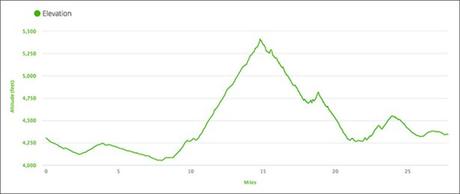
Thanks to a wrong turn early, this profile is off (long) by ~1.6 miles
Chuck and I continued ahead until soon the pack veered off the asphalt and on to the dirt. With great relief I saw a giant flour arrow on the ground, the first indication we were on the right track. Here the double-wide dirt trail stretched out ahead of us, and after passing the mile 3 marker I relaxed and settled in for a nice four-mile stretch of flat off-road running.
And I think I saw every mile marker after that.
The trail was largely hard-packed dirt with regular sections of shallow softer sand. Subtle to be sure, but insidious in making the legs — and especially the quads — work juuust a bit harder with every step. Assuming over 50,000 steps taken to complete a slower marathon like Bataan, this incremental extra work adds up in a hurry.
And speaking of extra work, I was wildly impressed to see so many soldiers moving swiftly and making great progress despite their 35-lb packs. Their arms swung stiffly at their sides, propelling them forward and presumably keeping their shoulders relaxed under the load. Their effort made me appreciate their resolve as well as my own decision to run light.
If I could have chosen a day to run in the southern New Mexico desert, this would have been it. A light breeze kept the air cool as the sun searched in vain for a break in the the clouds. And we fell into a rhythm of sorts, never easy on a dirt trail.
This would be the first time Chuck and I had raced together since the 2012 Brazen Diablo 50K, my first ultra and the historic race that had started this whole blogging thang. This had been a long time coming, though whether we’d be able to run the entire course together today, I had no idea. So I was determined to enjoy it while it lasted.
Imagine a poorly drawn version of Massachusetts on its side wielding a lasso, and that’s what the map of the BMDM route looks like. The course is run counterclockwise starting at the bottom. Marathoners run up the right half of Massachusetts (eight miles), followed by the lasso (12 miles) and finally down the left half of Massachusetts (6.2 miles). By contrast, participants in the Honorary March (14.2 miles) cover only the Massachusetts loop. Make sense? This is one of those times when a picture is worth a thousand words:

(Click for a larger version)
I ducked into a porta-potty in mile 6 and then hustled to catch up to Chuck, all while managing to keep my mile time under nine minutes. Nice. Chuck then made a pitstop of his own in mile 8, veering off with a “See you at the finish!” Nonchalant as my pace felt, I assumed he’d catch up to me soon enough, at the next aid station if not before.
Unless it’s hot, I’ll normally disregard aid stations during a marathon — I don’t sweat much, I don’t eat much. But I still had vivid recollections of my struggles in Tucson two years earlier, and so I knew that in the high dry New Mexico desert, failure to stay hydrated could have dire consequences — even on a relatively temperate day like today. And anyone running 26.2+ miles in the desert has enough to worry about without doing their best camel impression. So I forced myself to take two or three sips of water at every aid station. And lo and behold, I never felt thirsty.

Scenery along the course was exactly as you might expect, with plenty of sand and low-lying vegetation including creosote bush, grasses, sagebrush and succulents. Very little of the vegetation was taller than me (six feet), so I could see significant distances in all directions. To the west, the San Andres Mountains dominated the skyline, their silent majesty lending gravitas to the scene and imparting a sense that the spirits were watching over us.
And yet my brain half-expected to hear a “Meep! Meep!” and see the Road Runner speed by with Wile E. Coyote in hot pursuit on the back of an Acme rocket. So much for gravitas.
The downside to being taller than my surroundings was, of course, a lack of shade. In fact, if it hadn’t been for the persistent cloud cover, the only shade on the course would have been the US 70 underpass in mile 9 (and again on the return trip in mile 20). It was easy to imagine how brutal this course could be on a hot day.
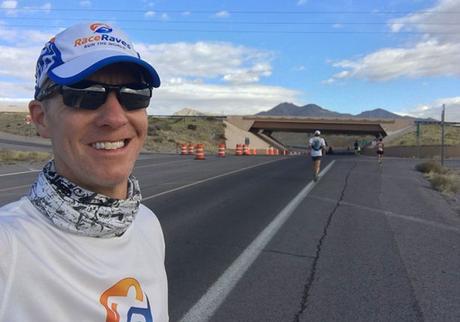
A shady mile 9, even without the US 70 underpass straight ahead
At the mile 8 marker the course turned right onto the main road (in my route description, the spoke of the lasso) and began a steady climb of six miles to its high point. The runners were spread out by now, and the next 3+ uphill miles on asphalt along the side of the highway were more mentally than physically challenging, with little to distract or motivate. So I was relieved to catch up to and fall in step with three students from the University of Colorado, who were setting a nice consistent pace on the uphill.
We chatted a bit, one of them asking me my finish time goal. “Under 4:30 if possible,” I responded. “How about you?” “Four hours,” he answered. I glanced at my watch, the current pace showing just over ten minutes per mile. Four hours — an average pace of 9:09/mile — would require a bit more effort on their part, and I wondered how realistic their goal was. With miles of downhill awaiting us, though, it could still be done.
Up, up, up we went.
Ahead of us I saw what looked like a cloud of smoke spanning the road, and my first thought was of someone grilling. Uh-oh. As we got closer, though, I realized the “smoke” was actually mist from sprayers set up on the side of the road to cool the runners. I was reluctant to run through the mist, not wanting to get my feet wet and risk blisters. But in the end, rather than swerve to avoid them I yielded, and as it turned out the mist was so light I barely felt it — a far cry from the dense cloud they’d projected from afar.
Up, up, up.
At last we saw signs of life as some low-lying buildings appeared in the distance — administrative buildings? barracks? Nearing aid station #5 and the end of the asphalt (for now), I pulled ahead of my three young pacers. I was more focused on the woman who’d just passed us moving with the resolve of a heat-seeking (or maybe finish line-seeking) missile.
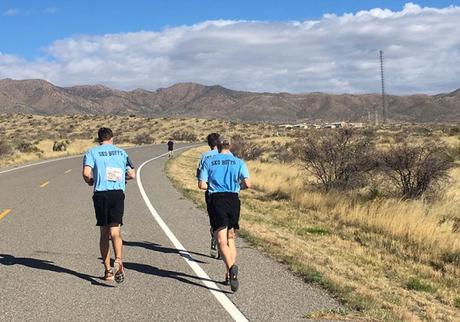
Pacing off my CU Buffs buddies in mile 11
Given the alternating stretches on asphalt and dirt, each new segment at Bataan felt like its own “mini race.” Back on the dirt now for the next mini race, the course continued its seemingly endless uphill trajectory as I struggled to keep my female hare in sight. Only two more miles of climbing, I promised my legs by way of motivation. I was looking forward to some much-deserved ”down” time.
Despite feeling increasingly sluggish, I passed a couple of runners who’d pulled ahead of me earlier but who now looked to be fading after the extended ascent. And at last we reached the high point of the course (5,400 ft) just past the midway point — oh, sweet downhill.
Aid station #6 signaled 14 miles down, and I ducked into a porta-potty to relieve the tension building in my stomach. My brief pitstop worked wonders, and I exited with renewed energy, ready to reclaim some momentum on the long descent.
Before setting off again I activated the Share My Run app on my phone, which would notify Katie and allow her to track my progress in real time for the last 12 miles. That way she wouldn’t be standing around waiting at the finish line any longer than necessary.
Onward and downward!
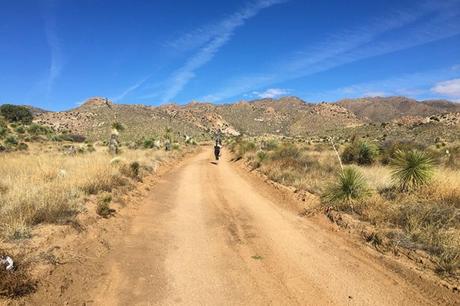
What goes up: Approaching the high point (5,400 ft) in mile 13
Marchers and sand pits and wind, oh my! (miles 15 – finish)
I refocused on making up time on the downhill, notching sub-9:00 times in two of the next four miles. Mile 16 in the marathon has always been a psychological boost for me — sure, ten miles is still a long way to go, but being able to count down the remaining mileage into single digits is always a pick-me-up. When you’re running 26.2 miles at a time, it helps to celebrate every little victory along the way. And to take nothing for granted.
Bataan isn’t your typical urban marathon, and there would be no pithy spectator signs or musical performers along the course. In fact, most of the music I heard came courtesy of runners/marchers carrying portable speakers in their packs — a bit annoying, since that’s what earbuds are for. The only memorable melody was the timely “Steady As She Goes” by the Raconteurs, with Jack White’s muffled voice blasting from one fellow’s pack as I hustled to pass him in the later miles.
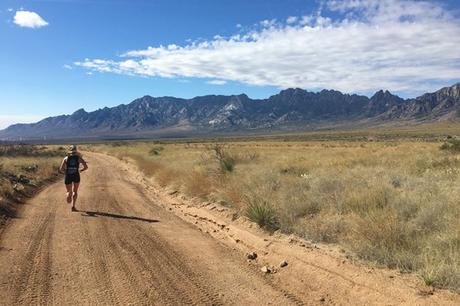
… must come down: Picking up the pace in mile 15
I paused as we passed the oddly ramshackle remains of the Hal Cox Ranch Headquarters, a cluster of dilapidated buildings that looked very much out of place here. I guessed — and the sign confirmed — that the ranch had been around and operating in the years before the land was annexed as part of the White Sands Missile Range.
Mile 19 signaled our return to asphalt, followed by a brief moment of confusion as a parade of marchers passed me going in the opposite direction. With my subpar sense of direction, it took me a minute to gather my wits and realize these folks were following the uphill route I’d already run, meaning I was nine miles ahead of them. But what really threw me off were their sheer numbers — the density of marchers here was similar to the crowds in mile one.
In that moment it struck me just how many Bataan participants take the word “march” seriously, and why the average finish times are so much slower than even other trail marathons. (Case in point, for my own Civilian Male Light Division, this year’s average finish time was 8:22:09, an average pace of 19:09/mile; for the Heavy Division, it was 9:25:59 or 21:36/mile.)
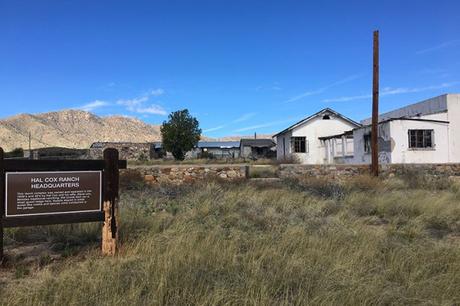
The ramshackle remains of Hal Cox Ranch, mile 19
Having completed the lasso loop of the course, I felt good as I let gravity pull me back down the spoke of the lasso on the shoulder of the highway. I’d earned these next two miles and planned to enjoy them. Several of the marchers heading uphill cheered me as I passed, and I returned the favor. “Man, I wish I was you right now!” yelled one fellow with a smile. I laughed and gave him a thumbs-up; I couldn’t help but agree.
You won’t often catch me saying this in mile 19 of a marathon, but this was fun.
Normally my legs will protest the hardness of asphalt after miles on dirt, but here they seemed to welcome the change of pace and respond well. It helped that I wasn’t pushing my body to its limit thanks to my Comrades Marathon qualifier run in Los Angeles seven days earlier, after which my thrashed quads had recovered just in time to board a plane to El Paso. All things considered, it was a beautiful day for a marathon.
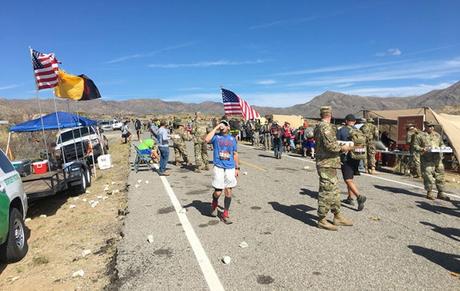
All business at Aid Station #8 in mile 19
Back through the Hwy 70 underpass with its momentary shade, then past the mile 20 marker where I sucked down my first and only GU of the day as I approached aid station #9. Here the course rejoined the lower loop and merged with the Honorary Marchers for the last 6.2 miles. Just in time for the infamous Sand Pit.
To (mis)quote Mark Twain, the rumors of the Bataan Sand Pit have been greatly exaggerated — and especially if you’re a trail runner. The Sand Pit awaits marchers almost immediately after the transition back to dirt in mile 21 and feels much like walking through a sandbox, minus the small shovels and pails. Without any signs to signal its beginning, its end or even its existence, it’s difficult to estimate its exact duration, but based on my Garmin I’d say the toughest footing persists for ½ to ¾ of a mile.
Admittedly the soft sand wasn’t the easiest running surface. More than anything, though, it was the slow-moving pack of Honorary Marchers together with a suddenly fierce headwind that slowed me to a march for stretches of the next two miles, before I’d quickly remember I didn’t have the patience for marching and start running again.
And though the Buff I’d worn around my neck in case of a sandstorm turned out to be unnecessary, I was glad I’d worn gaiters over my trail shoes to keep the soft sand out of my shoes and socks. If you plan to run or march Bataan, I’d recommend you do the same.
The irony wasn’t lost on me that, of the three Sohaskey siblings, the only one who couldn’t be here this weekend had been our sister — Sandy.
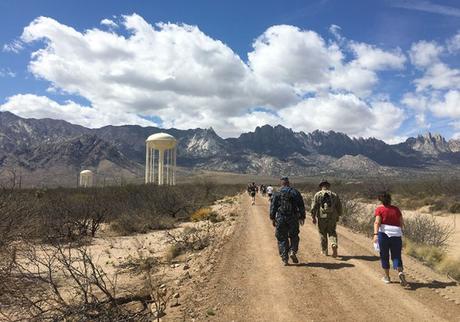
In the home stretch, mile 25
While it’s true the two miles including and immediately after the Sand Pit were my slowest of the day, I never really felt like the wheels were in danger of coming off. Which sadly couldn’t be said for the poor fellow sitting off to one side of the course being watched over by two race officials on ATVs — he wore a racing singlet and short shorts and looked like he may well have been on his way to winning this thing before his Ferrari ran out of gas.
At aid station #12, the last of the day, I grabbed two sips of water along with two sips of Gatorade and an orange slice — one last sugar kick for the home stretch. And I made sure to thank the volunteers, all 2,000 of whom had been at the top of their game all weekend. Because without the volunteers, there is no Bataan Memorial Death March.
Passing the mile 25 marker meant the end was in sight, though the finish line couldn’t come soon enough for the University of Minnesota runner whose team members — dressed in matching cross-country unis — helped to steady him as he looked ready to collapse.
The last mile leveled out nicely on smooth gravel, the tradeoff being a stiff headwind that was too little too late to keep me from almost enjoying this home stretch. I hadn’t looked at the time on my wrist in hours and had no idea if I was closer to four or five hours. And I didn’t care. All I knew was that I was about to complete one of the toughest marathons in the United States, thanks in part to 75,000 soldiers who 76 years earlier had endured more in six days than many people endure in a lifetime. And why? To guarantee all of us, marchers and non-marchers alike, the inalienable freedom to do what we love doing.
One last turn onto asphalt brought the final white metal timing “arch” into view, and with a wave to Katie state #20 was history in an official time of 4:35:04.

Katie sighting! Making the final turn to the finish
Shaking hands with history
Unlike other races, we’d already received our finisher’s medal — in this case, dog tags — in our goodie bag before the race. So the finish itself felt a bit anti-climactic without the ceremonial bestowing of the bling. That is, until…
Seated with his daughter in the tent just beyond the finish line sat Mr James J. Bollich, a Bataan survivor and geologist from Lafayette, Louisiana. Mr. Bollich seemed to be enjoying himself as he sat upright in his chair, greeting finishers. Still exhausted but trying to seem coherent, I struggled to find my voice as I shook his gloved hand. Then I thanked him for his service, for the opportunity and for everything he’d done to make this moment possible.
“How’d you do?” he asked. “Great day for a run,” I managed. I wasn’t about to admit to any kind of hardship or fatigue — not to a WWII veteran who had marched 69 miles in 110°F heat with a bayonet at his back, and then spent the rest of the war in a Japanese POW camp.
Mr. Bollich’s daughter (who’d driven out with him from Mobile, Alabama via Louisiana) told me he’d been blown away by the opportunity and the support, and I assured her the feeling was mutual. She too seemed to appreciate the outpouring of recognition and support that her father and his fellow soldiers had received from civilians and military personnel alike. This was their weekend, and we were all fortunate to be part of it.
Moving through the finish chute to the sidelines, I wrapped my arms around Katie in a happy finisher’s embrace. Then I set about trying to get comfortable — sit down, stand up, lean back, lean forward, repeat — while waiting for Chuck and Laura to finish. With the sun now directly overhead, the dry desert heat and altitude were having an impact and I sipped constantly at a bottle of water to stay hydrated, my mouth drying out quickly between sips.
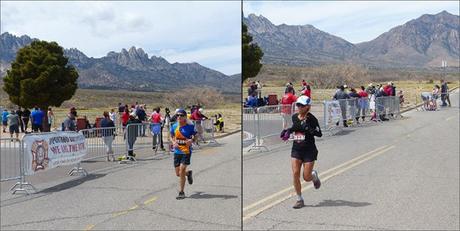
Chuck and Laura show off their finishing kick
I was surprised I hadn’t seen Chuck again after his mile 8 pitstop, though I’d glanced back several times in the hopes he’d be right behind me. No such luck. Turns out he’d hit a rough patch around the midway point and had struggled from there. But he looked good as he turned the final corner with the mountains behind him, coming home in 5:28:45 with Laura three minutes behind (and third in her age group!). Why he’d struggled so mightily he couldn’t be sure, but then again that’s the marathon — always a humbling experience, and some days more than others. Particularly in a place like White Sands.
We sat on the curb and then under the shade of the tents for a while, basking in our accomplishment. There wasn’t much in the way of entertainment in the post-race area, not that we were looking for a dance floor or bounce house. And with none of us having an appetite, we were unable to take advantage of the impressive post-race spread in the adjacent Frontier Club, where finishers feasted on hot dogs, veggie burgers, side dishes and drinks including soft drinks and canned beer.
Many marchers would be out on the course for several hours yet. But the day was still young, and so we limped back to the car for the 30-mile drive north to the White Sands National Monument, which more than lived up to its name as one of the few natural wonders in the nation more pale than me. And walking on the hard-packed sand dunes reminded me that yeah, the footing that morning could have been much worse.
My own trip into the New Mexico desert hadn’t been quite as life-changing as another doctor’s 56 years earlier, when gamma rays from an experimental bomb had tranformed Bruce Banner into the destructive superhero known as the Incredible Hulk. But to be able to experience 76 years of history through the eyes of those who lived it — that’s not something I’ll soon forget. And though my Marvel-loving younger self may not have understood, the reality — and one we can all live by — is that the strongest heroes among us aren’t always the largest or the loudest. Sorry, Hulk.
Glancing down at Google Maps on our drive back to Las Cruces, I had to smile as one name jumped out at me, a destination just north of us on I-25 that, unfortunately, we’d have to leave for another visit.
But what better state than New Mexico for a town called Truth or Consequences?
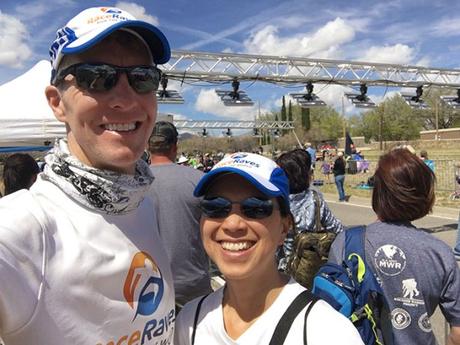
BOTTOM LINE: Are you a traveling runner in search of a uniquely inspiring (and patriotic) race experience? Or a 50 States runner looking for more than the usual race weekend of “fly in, collect t-shirt and medal, fly out”? Or maybe a recreational hiker looking to experience history through the eyes of those who lived it? All three opportunities await you on the White Sands Missile Range in the high desert of Southern New Mexico.
Bataan is a race with a purpose, and the marathon itself feels almost anticlimactic in the grand scheme of the weekend. In the words of one of the officers who spoke at the Opening Ceremony, race weekend is an opportunity “to honor the heroes of Bataan in a living history lesson.” If you aren’t familiar with the history of the event, I’d suggest you check out the race website for details.
This year, the 76th anniversary of the Bataan Death March in the Philippines during World War II, seven survivors remained on the Symbolic Roll Call. With each of them approaching or exceeding 100 years of age, soon there will be none. Bataan will always be a special event for what it represents and what it honors, but being able to hear one survivor tell his story and to shake another’s hand at the finish line was incredibly special. And I’d urge any runner reading this to register for next year’s race while there are still Bataan survivors among us. Survivors like centenarian Ben Skardon of South Carolina, who shared an extraordinary narrative of the horrors and humanity he experienced as a POW, forced by his Japanese captors to march 69 miles over five days in tropical heat of 110°F. Along the way, with the help of his fellow POWs he conquered hunger and disease without ever giving up hope. And yet years later, he was able to visit Japan as a free man who harbored no ill will toward his former captors or the Japanese people. That feels like heroism to me.
In a country and a time when few of us will ever be asked to make any real sacrifices in our lives, Bataan is an opportunity to pay our respects to those who did and to whom we owe the freedom and the comfortable lifestyle we readily take for granted.
And speaking of comfort, one suggestion for race day: you don’t necessarily need trail shoes (the course is ~25% asphalt, ~75% dirt/sand), but do consider wearing gaiters to prevent any sand or small rocks from finding their way into your shoes and forcing you to either run in discomfort or stop to shake out your shoes along the course.
The upshot? Road shoes, trail shoes, marching boots or bare feet, it doesn’t matter — run/march Bataan and do it soon, before our nation’s last living connections to World War II are gone forever.
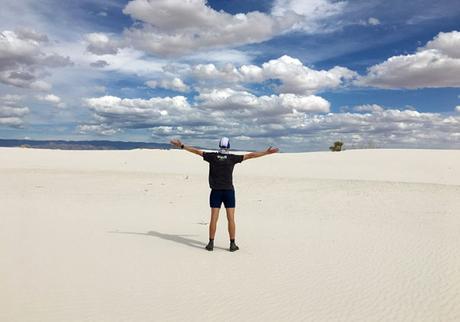
Looking SoCal-tan at the White Sands National Monument
PRODUCTION: Throw out the first two miles, and the weekend ran with almost military precision. The most conspicuous race-day error was an apparent lack of signage in mile 2, resulting in a wrong turn that led hundreds of runners astray and added ~1.6 miles to my own total. Had this been most other races the fallout might have been loud and belligerent, but Bataan isn’t most other races — no one is there to set a personal best or qualify for Boston, and so instead I congratulated myself on my 4:34 finish in the inaugurual Bataan Memorial Death March Ultramarathon.
A couple of other race-day suggestions: 1) increase the number of porta-potties at the start, and especially if the event continues to increase its participant cap as it did this year with a record 8,460 marchers — unable or unwilling to fight the call of nature, many military personnel and civilians (like me) experienced the Opening Ceremony from our place in the long porta-potty lines; 2) create an actual start arch, or at least add clear signage to the existing “arch” (i.e. first timing station) to give runners and marchers a better sense for the start line.
Based on my Garmin the 26.2 miles of the official course were well measured, and after missing the first three mile markers due to the crowds, I saw every marker from mile 4 on. On the dirt portions once the runners spread out, there were a couple of side roads and potential detours off the main trail that could have been more clearly marked as “Wrong Way,” but even my own questionable sense of direction didn’t lead me down any of them.
Every one of the 2,000 volunteers, comprising both civilian and military personnel, was amazing. With 100% focus on the marchers and their needs, there was no drama and no distractions. I never had to waste valuable energy guessing who had water and who had Gatorade — that was made clear as I approached each aid station. A heartfelt THANK YOU to all the volunteers whose selfless hard work made Bataan weekend in White Sands a huge success.
As usual my appetite abandoned me after the race, despite an impressive selection of post-race food. The organizers did a nice job of refueling their marchers, offering all participants an entrée (including hot dogs and veggie burgers) plus three side dishes and a drink, with soft drinks and canned beer available. It all added up to one of the better post-race spreads I’ve seen at a marathon.
One last recommendation for the organizers would be to post the 6½-minute high-speed course video — shown on a loop at the expo — on the race website, to give all prospective runners a better sense for the terrain. (I’ve added it to the Bataan race page on RaceRaves). I knew to expect hot dry weather on race day, so course layout and terrain were the biggest wild cards. And preparation is the cornerstone of a good soldier!
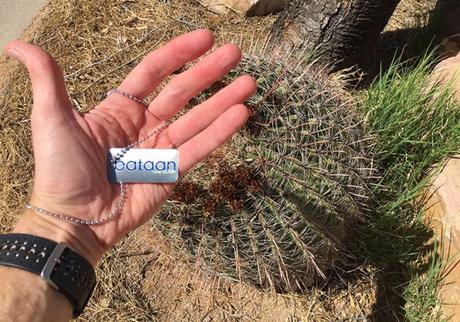
SWAG: Nobody runs Bataan for the swag, and in fact it almost feels like an afterthought with all runners/marchers receiving their swag in a reusable goodie bag before the race. And though I missed the pomp and circumstance of receiving a medal after crossing the finish, thumbs up to the organizers for the appropriate choice of dog tags rather than finisher medals. (The only problem with dog tags is they’re relatively small and, when hung on a wall alongside larger finisher medals, easily overshadowed.) Another cool touch would have been for the event to offer engraving services (e.g. name and finish time) à la actual dog tags at the post-race festival. At any rate, the dog tags are definitely one of my more unique and memorable pieces of swag.
Sadly I can’t say the same for the shirt, a neon green Gildan cotton tee with “bataan” printed in thin, unimpressive blue letters on the front and which I can’t see myself wearing among my collection of race tees.
Along with their bib number all marchers received a full-color “Certificate of Participation,” which the WSMR Arts & Crafts Center would custom frame — along with your dog tags and challenge coin — for $65 at the expo/In-Processing while you waited. This service wasn’t available at the post-race festival, so if you’re interested in a cool keepsake you should jump on this opportunity before the race.
Updated 50 States Map:
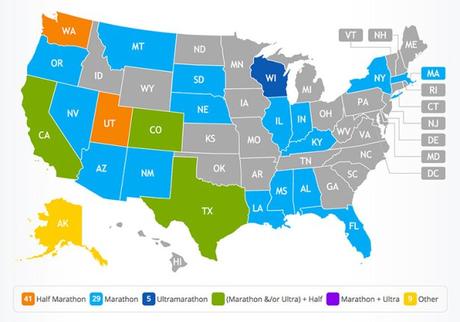
RaceRaves rating:

FINAL STATS:
Mar 25, 2018 (start time 7:30am)
27.81 miles in White Sands Missile Range, NM (state 20 of 50)
Finish time & pace: 4:35:04 (first time running the Bataan Memorial Death March), 9:53/mile
Finish place: 41 overall in Individual Civilian Light Division, 14/313 in M 40-49 age group
Number of finishers: 8,460 total (66% men, 34% women); 2,393 in Individual Civilian Light Division (1,362 men, 1,031 women)
Race weather: cool (57°F) & partly cloudy at the start, warm (72°F) and partly cloudy at the finish, breezy early & gusty later
Elevation change (Garmin Connect): 1,944 ft ascent, 1,900 ft descent
Elevation min, max: 4,052 ft, 5,411 ft

